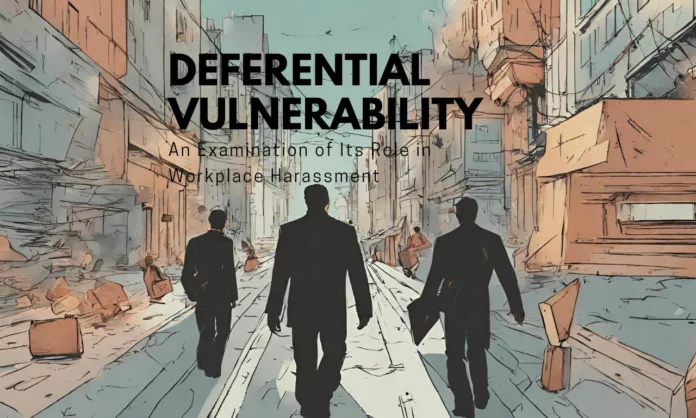Deferential vulnerability is a concept that often arises in discussions of power dynamics and interpersonal relationships. It refers to situations where one individual, often due to their subordinate position or fear of consequences, feels compelled to defer to another, potentially at the expense of their own well-being. This dynamic can manifest in various contexts, but one prominent example is in the workplace, where it can play a significant role in situations involving harassment.
Table of Contents
Understanding Deferential Vulnerability
Deferential vulnerability can be understood as a situation in which an individual, typically in a subordinate or less powerful position, feels vulnerable and powerless in interactions with a more dominant or authoritative figure. This vulnerability can stem from a variety of factors, including the fear of retaliation, job security concerns, or societal norms that reinforce the authority of the more powerful party.
Workplace Harassment as an Example
Workplace harassment is a prime example of a situation where deferential vulnerability might be a factor. Now, let’s delve deeper into this concept:
- Hierarchical Structures: Many workplaces have hierarchical structures, with supervisors, managers, and executives holding positions of authority over their subordinates. This power imbalance can create an environment where employees may feel deferentially vulnerable, and hesitant to speak up or challenge the actions of those in higher positions.
- Fear of Retaliation: Employees may fear retaliation if they report harassment or inappropriate behavior by a colleague or superior. This fear can result in their reluctance to come forward, even when faced with uncomfortable or harmful situations.
- Job Security Concerns: In situations where an individual’s livelihood depends on their job, they may feel deferentially vulnerable and be less likely to report harassment. The fear of losing their job, especially in a competitive job market, can be a significant barrier to speaking out.
- Cultural and Gender Dynamics: Cultural and gender dynamics can also contribute to deferential vulnerability in the workplace. For example, societal norms may dictate that women should be subservient to men, leading some female employees to tolerate harassment or inappropriate behavior rather than challenge it.
- Lack of Reporting Mechanisms: If a workplace lacks effective reporting mechanisms or a culture of accountability, deferential vulnerability can persist. Without a clear path to address harassment, victims may be more likely to suffer in silence.
- Legal and Organizational Protections: In some cases, employees may not be aware of their legal rights or organizational policies that protect them from harassment. This lack of knowledge can further exacerbate deferential vulnerability.
Addressing Deferential Vulnerability in the Workplace
To combat deferential vulnerability and create a safer work environment, organizations can take several steps:
- Establish Clear Reporting Procedures: Companies should implement and publicize clear reporting procedures for harassment, ensuring that employees know how to raise concerns and what protections are in place.
- Promote a Culture of Respect: Fostering a workplace culture that values respect, diversity, and inclusion can go a long way in preventing harassment and reducing deferential vulnerability.
- Training and Education: Providing training and education on harassment prevention and bystander intervention can empower employees to speak up and challenge inappropriate behavior.
- Legal Protections: Employers should not only adhere to legal protections against harassment but also go above and beyond to create a supportive and safe work environment.
Conclusion
Deferential vulnerability is a complex and multi-faceted concept that can manifest in various situations, including workplace harassment. Recognizing and addressing this vulnerability is crucial for creating a workplace where all employees feel safe, respected, and empowered to speak up against harassment. By implementing clear reporting procedures, promoting a culture of respect, and providing education and training, organizations can take meaningful steps toward mitigating deferential vulnerability and fostering a healthier and more equitable work environment.

